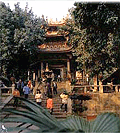Nanputuo Temple South Putuo Temple is situated below the Five Old Gentlemen Peaks in the southern part of the island of Xiamen. It was first built in the Tang Dynasty and is one of the sacred places of Buddhism in Southern Fujian. Inside the temple there are the Heaven King’s Hall, the Daxiong Hall, the Great Compassion Hall, all of which are built in an exquisite and grand style. Enshrined in these halls are the statues of Maitreya, Sanshi Reverend Buddha, Thousand-handed Guanyin (Bodhisattva), Four Kings of Heaven, and the eighteen archats.  Although all are serious and solumn in appearance, each is distinctly different from another. The temple attracts a large number of pilgrims at home and from abroad. The excellent craftsmanship of the Thousand-handed Guanyin is marked by its thousand hands and thousand eyes and glistening golden colour. As to the Pavilion where Buddhist scriptures are kept, it has a rich collection of the historical articles of Buddhism. such as classics, statues of Buddhas, bronze bells from the Song Dynasty, calligraphic works and paintings from the ancient times. Among them, “Intriguing Lotus Scripture” written in blood in the Wanli period of the Ming Dynasty and the statue of Guanyin in white porcelain, a masterpiece of He Chaosong, are most valuable.
Although all are serious and solumn in appearance, each is distinctly different from another. The temple attracts a large number of pilgrims at home and from abroad. The excellent craftsmanship of the Thousand-handed Guanyin is marked by its thousand hands and thousand eyes and glistening golden colour. As to the Pavilion where Buddhist scriptures are kept, it has a rich collection of the historical articles of Buddhism. such as classics, statues of Buddhas, bronze bells from the Song Dynasty, calligraphic works and paintings from the ancient times. Among them, “Intriguing Lotus Scripture” written in blood in the Wanli period of the Ming Dynasty and the statue of Guanyin in white porcelain, a masterpiece of He Chaosong, are most valuable.  In the temple are preserved many inscriptions, among which the stone inscriptions written by Chen Di and Sheng Yourong in the Wanli period of the Ming Dynasty and the one on a stone stele written by Emperor of the Kangxi period of the Qing Dynasty are most famous. Behind the temple, inscribed on the wall of a rock is a large word “Buddha” which is 4.66 metres in height and 3.33 metres in width. And farther behind, high up on the mountain stands a screen of five peaks coloured by green trees and bamboos and marked by serene valleys and rocks of pleasing shapes. They are called “Five Old Gentlemen Reaching the Clouds,” and are one of the eight grand sights of Xiamen. Coming to the top, you not only have a view of the mountain undulating in the wind, but also the view of the sea surging in the distance.
In the temple are preserved many inscriptions, among which the stone inscriptions written by Chen Di and Sheng Yourong in the Wanli period of the Ming Dynasty and the one on a stone stele written by Emperor of the Kangxi period of the Qing Dynasty are most famous. Behind the temple, inscribed on the wall of a rock is a large word “Buddha” which is 4.66 metres in height and 3.33 metres in width. And farther behind, high up on the mountain stands a screen of five peaks coloured by green trees and bamboos and marked by serene valleys and rocks of pleasing shapes. They are called “Five Old Gentlemen Reaching the Clouds,” and are one of the eight grand sights of Xiamen. Coming to the top, you not only have a view of the mountain undulating in the wind, but also the view of the sea surging in the distance.